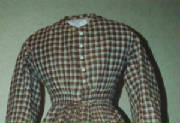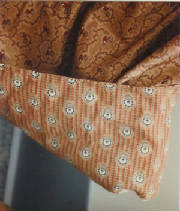|

Bodice
Bodices for work dresses are generally lined and have piping at the
neckline, armscye, bottom of waistband, and at the wrist of coat sleeves. Work dresses can have collars or you can wear a
scarf at the neck.
Sleeves
Work dresses need sleeves that could be rolled up out of the way.
Both the coat sleeve and the bishop sleeve were used on original work dresses.
Skirt
The skirt of the work dress is full all around and gauged into the
waist of the bodice. Heavy homespun is sometimes gathered into the waist rather than gauged.
Pocket
Often only one, set into the seam on the side of the front skirt panel.

|
| Example of a hem facing of a fabric different from the dress. |
Skirt Hem
No more than 4” above ground and faced for dress protection
and fullness. Hem facing can be of scraps. Hem braid, usually wool, also on the bottom edge to protect it from wear. The hem
can also use be turned up as work dresses are shorter than nicer dresses.
The hem circumference is between 120 inches and
140 inches. The skirt is usually plain with no decoration or embellishment and usually unlined due to the heavier fabric used.
Gauging
Fold over the top of the fabric at least an inch, run two exactly
parallel lines of hand stitching through both layers, then stitch the top of each accordion fold into the bodice or waistband
by hand. See illustrated gauging instructions online by Glenna Jo Christen or Elizabeth Stewart Clark.
|

